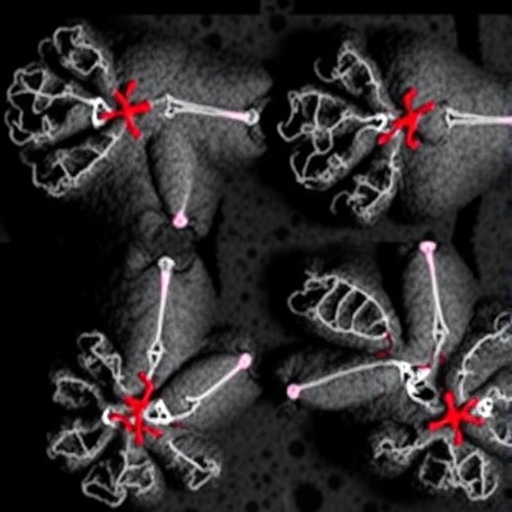In recent years, the frontier of biotechnology has witnessed a transformative convergence of biology with electronics and microfluidics, giving rise to hybrid engineered biological systems. These sophisticated platforms leverage the intrinsic capabilities of living cells or cell-free biological components, such as DNA-based sensors, integrated meticulously with cutting-edge electronic circuits and fluidic devices. The result is a new generation of biological systems that are not only capable of sensing complex biochemical cues but also of processing information, producing responses, and reporting findings with unprecedented precision. This interdisciplinary fusion is reshaping how researchers approach challenges ranging from personalized medicine and environmental surveillance to agricultural innovation and ecosystem remediation.
Central to this paradigm shift is the ability to seamlessly marry biological functionalities with engineered physical components. Microbes, traditionally viewed as isolated biological entities, are now being embedded within microfluidic architectures where fluids containing substrates or analytes can be precisely manipulated under electronic control. These engineered microbes or cell-free systems serve as living sensors or actuators, responding dynamically to environmental triggers. The intimate integration with electronics affords enhanced signal transduction, data acquisition, and real-time feedback loops, effectively turning biological systems into cyber-physical entities. This hybridization overcomes limitations inherent in purely biological or purely electronic sensors, such as slow response times, limited sensitivity, or inadequate specificity.
Delving into the design principles underlying these hybrid systems reveals a complex interplay of biological engineering, materials science, electrical engineering, and computational modeling. Researchers must consider factors such as biocompatibility, microenvironment control, communication interfaces, and energy supply. For instance, the microfluidic setup not only serves as a conduit but is often engineered to establish gradients, isolate single cells, or create high-throughput screening arrays, tailoring the biological response to the specific application. Meanwhile, the electronic elements must maintain sensitivity and selectivity to biological signals, sometimes requiring novel nanoscale transducers or bioelectronic interfaces, ensuring that signals from biological processes are accurately captured and digitized.
.adsslot_s9nGO7avdS{ width:728px !important; height:90px !important; }
@media (max-width:1199px) { .adsslot_s9nGO7avdS{ width:468px !important; height:60px !important; } }
@media (max-width:767px) { .adsslot_s9nGO7avdS{ width:320px !important; height:50px !important; } }
ADVERTISEMENT
One of the transformative impacts of these hybrid systems lies in healthcare. Engineered bacteria, coupled with electronics, are being explored for in situ diagnostics, capable of detecting markers of disease directly within the human body or in biopsied samples. The integration of microfluidics enables the handling of tiny volumes, facilitating rapid assays with minimal invasiveness. This could herald a new era of personalized medicine, where biohybrid devices continuously monitor physiological states, detect pathogens or metabolic imbalances, and even trigger the release of therapeutic agents in real-time. Such closed-loop systems exemplify the potential of cyber-biological integration to transcend traditional boundaries in diagnostics and therapy.
Beyond healthcare, environmental monitoring stands to benefit enormously from these advances. Microbial consortia engineered to recognize pollutants can be embedded within microfluidic devices deployed in natural habitats, waterways, or industrial effluents. Coupled with electronic readouts, these devices can provide continuous, remote monitoring of environmental health at molecular specificity. The integration allows for early detection of contamination, facilitating timely interventions. Moreover, these engineered systems can be adapted for bioremediation, sensing and degrading environmental toxins while reporting the progress electronically, providing a dual function rarely achievable by conventional methods.
Agricultural applications present another fertile ground for the deployment of hybrid engineered biological systems. The ability to monitor soil health, detect pathogen presence, or gauge nutrient levels through embedded biosensors integrated with microfluidics and electronics could revolutionize precision farming. Such systems could provide farmers with actionable data streams, enabling optimized irrigation, fertilization, and pest management practices that enhance yields while reducing environmental impact. The scalability of microfluidic and electronic components ensures that these solutions can be adapted for use in varied agricultural landscapes, from smallholder farms to industrial-scale operations.
While the promise of these hybrid engineered systems is immense, their design and deployment are accompanied by significant challenges. Critical among these is the need to maintain biosafety and biocontainment. The living components must be securely encapsulated within devices to prevent unintended environmental release while ensuring their functional longevity. Moreover, integrating living systems with inorganic electronics requires harmonizing disparate physical and chemical environments. Issues like biofouling, electronic noise, stability of biological components, and cross-talk between the biological and electronic domains must be managed through innovative materials, coatings, and device architectures.
Another emerging and essential consideration is cybersecurity within biohybrid systems. As these engineered biological devices become more interconnected and reliant on digital infrastructure for data transmission and control, they become potentially vulnerable to cyberattacks. Malicious interference could compromise both data integrity and biological activity, posing risks to health, environment, and security. Proactively developing cyber-secure biological systems involves incorporating encryption, secure data channels, tamper sensors, and fail-safe mechanisms, elevating these devices beyond conventional cyber-physical security frameworks into the realm of living, responsive organisms.
The need for a cohesive framework to guide the design and optimization of hybrid engineered biological systems is increasingly recognized. Researchers are calling for classification schemas that delineate system components, functional modes, biological interfaces, and application contexts. Such frameworks aid in harmonizing terminology, benchmarking performance metrics, and fostering interoperability between device components developed across disparate disciplines. By systematically categorizing design choices, biological platforms, and electronic interfaces, the field can accelerate innovation while mitigating redundancy and facilitating technology transfer.
To capture the rapid developments and encourage collaborative progress, several initiatives have introduced dynamic, interactive platforms that serve as “living roadmaps” for the field. These online resources aggregate the latest research breakthroughs, technology trends, design templates, and community-contributed updates. They empower researchers to track emerging methodologies, identify gaps, and contribute insights, thereby catalyzing accelerated collective learning. Such living databases are integral to a community-driven scientific ecosystem where the boundary between biology, electronics, and information technology is increasingly blurred.
At the heart of these hybrid systems are engineered biological components, such as microbes rewired through synthetic biology or cell-free DNA constructs designed for molecular recognition. Synthetic biology techniques allow for the modular design and precise tuning of genetic circuits, enabling living sensors to respond with calibrated outputs. Meanwhile, cell-free systems boast advantages in safety and programmability, as they eschew living cells while retaining functional biomolecules capable of sensing and computation. Embedding these components within microfluidic systems enhances control over chemical gradients, reaction kinetics, and multiplexing capabilities, thereby expanding the functional repertoire of engineered biosystems.
Integration with electronics extends beyond signal detection to encompass actuation and control. Advanced bioelectronic interfaces enable bidirectional communication, where biological states influence electronic controls, and electronic signals modulate biological behavior. This intertwining allows for responsive systems capable of adaptation and learning, pointing toward future biohybrid devices with autonomous functions. For example, electronic stimuli could synchronize gene expression rhythms or initiate on-demand metabolic switches, broadening the scope of synthetic biology applications.
The microfluidic dimension adds unparalleled versatility, facilitating complex sample manipulation and real-time monitoring within compact form factors. Innovations in microfabrication have made it possible to create intricate channels, valves, and compartments that faithfully mimic biological microenvironments or scale-up parallel assays. The miniaturization and portability conferred by microfluidics pave the way toward point-of-care diagnostics, wearable biosensors, and field-deployable environmental monitors, democratizing access to sophisticated biotechnologies.
Future trajectories in the domain envisage the refinement of hybrid engineered biological systems into fully cybersecure, autonomous platforms embedded in the Internet of Things (IoT). By harnessing cloud computing, machine learning, and encrypted communication, these devices could form decentralized networks delivering continuous, real-time bioanalytics at a global scale. Such integration promises transformative impacts on public health surveillance, environmental stewardship, and sustainable agriculture, driving a new industrial biotechnology epoch guided by interconnected, intelligent biological machines.
In conclusion, the marriage of electronics, microfluidics, and engineered biological systems signifies a bold stride in bioengineering, offering unprecedented capabilities and applications. Overcoming design challenges and forging robust cyberbiosecurity frameworks are critical to unlocking this technology’s full potential. The ongoing creation of classification frameworks and dynamic living roadmaps illustrates the field’s commitment to collaborative progress and transparency. As the hybrid bioelectronic frontier continues to evolve at breakneck speed, it holds the key to next-generation solutions for some of humanity’s most pressing challenges across health, environment, and agriculture.
Subject of Research: Hybrid engineered biological systems integrating electronics and microfluidics with engineered biological components for sensing, actuation, and reporting in biological environments.
Article Title: Improving engineered biological systems with electronics and microfluidics.
Article References:
Yazicigil, R.T., Bali, A., Caygara, D. et al. Improving engineered biological systems with electronics and microfluidics.
Nat Biotechnol (2025). https://doi.org/10.1038/s41587-025-02709-6
Image Credits: AI Generated
Tags: agricultural biotechnology advancementscyber-physical biological systemsDNA-based biosensorsengineered biology and electronicsenvironmental monitoring technologieshybrid biological systemsintegrated electronic circuits in biosensorsinterdisciplinary convergence in biotechnologyliving sensors and actuatorsmicrofluidic systems in biotechnologypersonalized medicine innovationsreal-time data acquisition in biology





